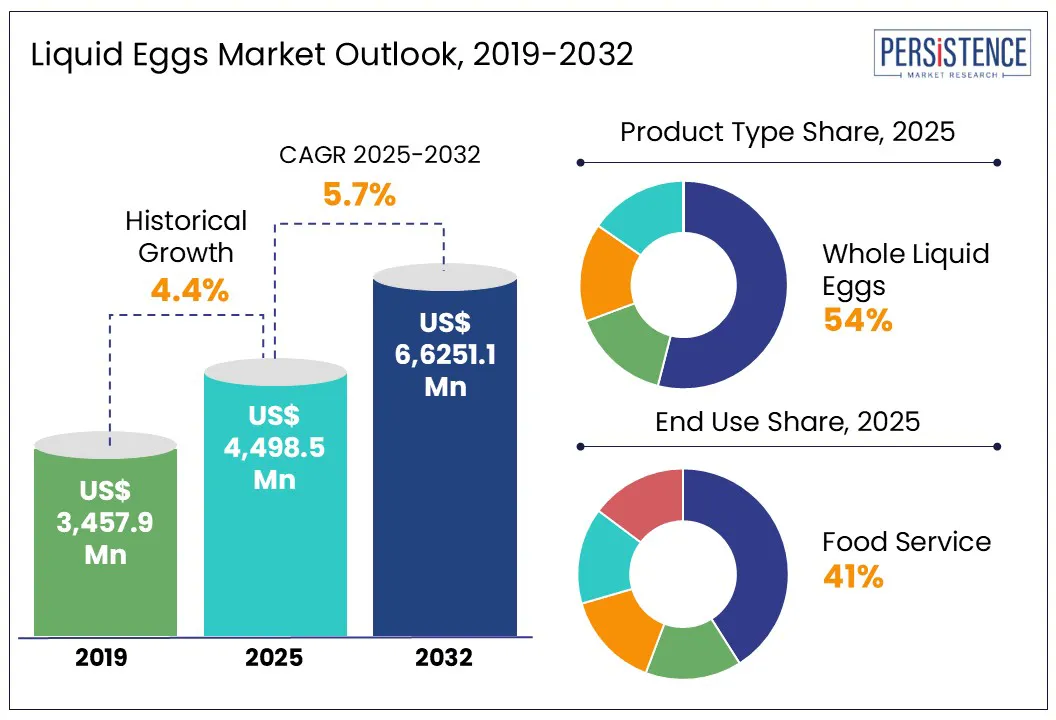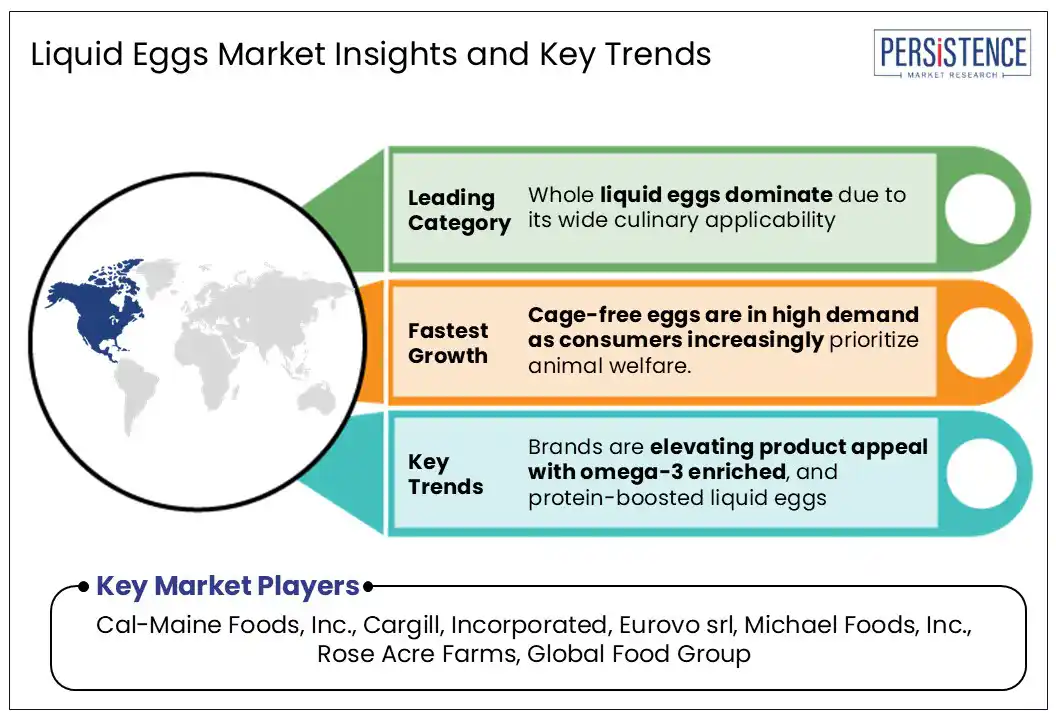ID: PMRREP25012| 400 Pages | 27 Jun 2025 | Format: PDF, Excel, PPT* | Food and Beverages

The Global Liquid Eggs Market size is likely to be valued at US$4,498.5 million in 2025 and is expected to reach US$ 6,625.1 million by 2032, growing at a CAGR of 5.7% during the forecast period 2025 to 2032.
According to the Persistence Market Research report, the liquid eggs market is poised for robust growth, driven by the rising demand for convenience food and expansions in the foodservice industry. Innovation in value-added and ethically sourced variants, particularly cage-free practices are critical for market players to maintain competitive edge against the rising plant-based competition and reflect more on evolving consumer preferences.

Key Industry Highlights:
|
Global Market Attribute |
Key Insights |
|
Global Liquid Eggs Market Size (2025E) |
US$ 4,498.5 Mn |
|
Market Value Forecast (2032F) |
US$ 6,625.1 Mn |
|
Projected Growth (CAGR 2025 to 2032) |
4.4% |
|
Historical Market Growth (CAGR 2019 to 2024) |
5.7% |
The foodservice industry's increasing reliance on pre-processed ingredients is a primary catalyst for the rising demand for liquid eggs. Faced with the rise in labor costs, shrinking kitchen spaces, and the need for consistent quality, foodservice operators are opting for ready-to-use liquid eggs over traditional shell eggs. These pre-processed products significantly lowers preparation time, reduce food safety hazards, and enable precise portion control. These benefits are crucial for maintaining operational efficiency in high-volume environments. According to the USDA, the U.S. foodservice sector generated a staggering $1.5 trillion in 2023, with full-service restaurants accounting for $513.3 billion and limited-service outlets contributing $521.0 billion. This vast and expanding sector requires scalable, dependable, and safe ingredients like pasteurized liquid eggs to satisfy consumer expectations while simultaneously streamlining back-of-house operations.
Furthermore, as Quick Service Restaurants (QSRs) and meal kit providers continue to grow, liquid eggs prove to be an adaptable protein source for breakfast offerings, sauces, and baked goods, making them an indispensable component in today's commercial kitchens.
A significant constraint within the liquid egg market is the rise in competition from plant-based egg substitutes. These alternatives boast a longer shelf life and effectively cater to the increasing demand for allergen-free, vegan, and cholesterol-free options. Such substitutes have gained a considerable momentum among health-conscious consumers, institutional purchasers, and food manufacturers who seek ingredient versatility without sacrificing dietary inclusivity. While liquid eggs are appealing to foodservice operations their protein quality, plant-based products are witnessing a rise in growing adoption in egg-free baking, breakfast formulations, and various sauces. This trend is particularly evident in regions that experience high vegan population growth or face regulatory pressures concerning animal products.
Furthermore, their ability to be stored at ambient temperatures and their extended shelf stability offer a distinct advantage by reducing cold chain expenses. This escalating competitive pressure is compelling traditional egg producers to innovate, fortify their offerings, or diversify their product lines to maintain relevance within an evolving protein landscape.
A key opportunity in the liquid egg market lies in offering flavored and culinary-specific variants that address evolving consumer preferences and niche dietary needs. Beyond standard formulations, value-added options such as pre-seasoned, herb-infused, or flavor-enhanced liquid eggs enable foodservice operators and consumers to reduce preparation time while simultaneously adding gourmet appeal. For example, MuscleEgg has successfully capitalized on this segment by providing flavored liquid egg whites in options such as chocolate, vanilla, and strawberry, specifically targeting fitness-conscious consumers who seek high-protein, ready-to-drink solutions. This innovation demonstrates the potential to diversify product portfolios and unlock new demand within the retail, meal-preparation, and sports nutrition segments. Furthermore, culinary-specific variants, such as scrambled egg blends or quiche-ready mixes, support precision cooking in Quick Service Restaurants (QSRs) and catering operations. As convenience and flavor innovation converge, flavored liquid eggs present a strategic lever for market differentiation and consumer engagement.
Whole liquid eggs are poised to account for approximately 54% of the market share in 2024, firmly dominating the liquid eggs market due to their extensive culinary applicability and balanced nutritional profile. Their versatility is unmatched, spanning applications in baking, general cooking, and ready-to-eat formulations, making them indispensable across both foodservice and industrial sectors. Whole liquid eggs consistently deliver the essential texture, emulsification, and binding properties required in products such as sauces, bakery items, and prepared meals, which explains their strong preference among chefs and manufacturers alike.
Meanwhile, liquid egg yolks are steadily gaining traction, prized for their rich flavor and fat content. They are crucial in premium bakery goods, dressings, and specialty sauces, where they significantly enhance both taste and mouthfeel. Additionally, scrambled egg mixes, frequently pre-seasoned and fortified, cater to foodservice segments that prioritize convenience without compromising quality, particularly in breakfast-focused quick-service restaurants. This growing specialization further enriches the market by precisely meeting diverse culinary demands.
Cage-free eggs are projected to grow at a CAGR of 6.9% during the forecast period from 2025 to 2032, primarily driven by increasing consumer awareness regarding animal welfare and ethical sourcing. As transparency becomes a core purchasing criterion, more consumers are demanding eggs from hens raised in humane, non-caged environments. This shift is no longer confined to niche health food circles; it's increasingly becoming mainstream, influencing both retail and foodservice procurement policies.
Retailers and Quick Service Restaurant (QSR) chains have responded with cage-free pledges, aligning with their Environmental, Social, and Governance (ESG) goals and public expectations. Additionally, the association of cage-free eggs with superior quality, freshness, and safer production practices is further enhancing their appeal. While these eggs typically carry a premium, many consumers are willing to pay more for the perceived ethical and health benefits. The demand is catalyzing significant supply chain adjustments and investments in cage-free compliant facilities worldwide.

The North America liquid eggs market is witnessing robust growth, driven by multiple converging trends, particularly in the U.S. The surging demand from the foodservice sector in the U.S., combined with busy lifestyles and a growing preference for ready-to-use, time-saving food solutions is accelerating the adoption of liquid eggs across both commercial kitchens and retail. Consumers in the U.S. are increasingly shifting toward cage-free and ethically sourced products. The U.S. Department of Agriculture data shows that over 40% of egg-laying hens in the U.S. are now cage-free.
Additionally, technological advancements in processing and aseptic packaging are enhancing shelf life and safety, making liquid eggs more viable for distribution at scale. In Canada, stringent food safety regulations and mandatory pasteurization further reinforce consumer confidence, supporting steady market expansion across the region. Overall, ethical sourcing and efficiency remain central to liquid egg growth in North America.
The Asia Pacific region is projected to reach at a CAGR of 7.2% during the forecast period, fueled by dynamic shifts in consumer behavior, the expansion of the foodservice sector, and increasing industrial food production. In India, the flourishing bakery and confectionery industry, combined with a growing urban population and increasingly busy lifestyles, is accelerating the demand for convenient, ready-to-use ingredients such as liquid eggs. Simultaneously, the rise of ready-to-eat (RTE) meals and processed foods across emerging economies is bolstering the adoption of pasteurized egg formats due to their safety, efficiency, and consistency.
In China, technological advancements in egg processing and packaging are enhancing shelf life and ensuring regulatory compliance, which supports broader market penetration. Meanwhile, in Japan, the cultural and culinary significance of egg yolks is frequently used in sauces, desserts, and traditional dishes drives consistent demand for high-quality liquid yolk products. Collectively, these factors position Asia Pacific as a key growth frontier in the global liquid egg industry.
The consolidated nature of the global liquid eggs market is defined by a handful of vertically integrated players leveraging scale, technology, and strategic expansion to maintain dominance. Companies are investing in large-scale production facilities equipped with advanced automation in egg breaking, separation, pasteurization, and packaging to boost operational efficiency and consistency. The implementation of HACCP, ISO, and similar certifications is becoming standard, reinforcing trust in product safety.
At the same time, leading players are developing value-added and functional products, such as fortified or flavored variants, to differentiate their portfolios. There is also a growing shift toward cage-free and ethically sourced eggs, reflecting evolving consumer values. Innovation in packaging solutions to extend shelf life and improve convenience is a key priority. Additionally, AI-driven optimization across the supply chain, from flock management to processing and inventory, is reshaping cost structures. Mergers and acquisitions are further accelerating geographic and product expansion.
The global Liquid Eggs market is projected to be valued at US$4,498.5 Mn in 2025.
Rising reliance on pre-processed ingredients by the food service industry drives the demand for liquid eggs.
The global liquid eggs market is poised to witness a CAGR of 5.7% between 2025 and 2032.
Offering flavored & culinary-specific liquid egg products is the key market opportunity.
Major players in the global liquid eggs market include Cal-Maine Foods, Inc., Cargill, Incorporated, Eurovo srl, Michael Foods, Inc., Rose Acre Farms, Global Food Group, and others.
|
Report Attribute |
Details |
|
Historical Data/Actuals |
2019 - 2024 |
|
Forecast Period |
2025 - 2032 |
|
Market Analysis |
Value: US$ Mn |
|
Geographical Coverage |
|
|
Segmental Coverage |
|
|
Competitive Analysis |
|
|
Report Highlights |
|
|
Customization and Pricing |
Available upon request |
By Product Type
By Source
By End-use
By Sales Channel
By Region
Delivery Timelines
For more information on this report and its delivery timelines please get in touch with our sales team.
About Author